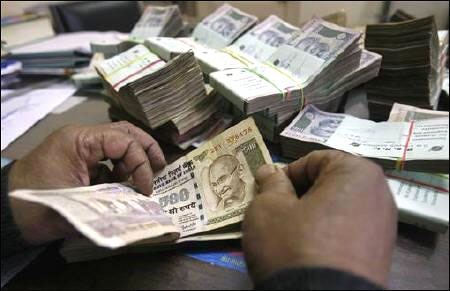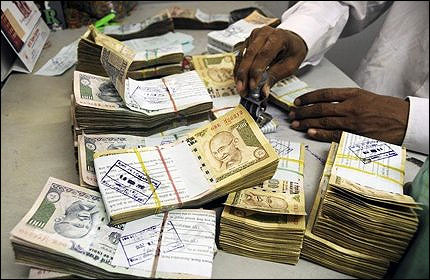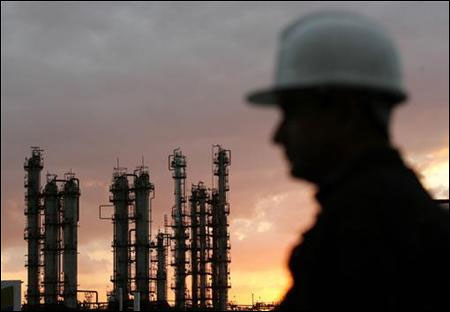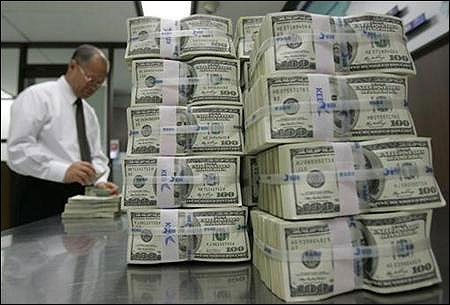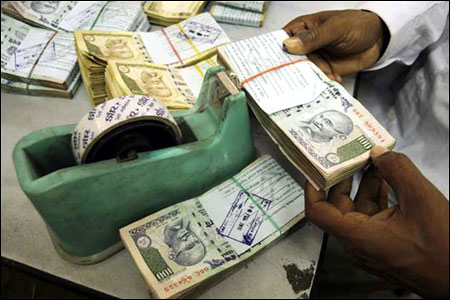 | « Back to article | Print this article |
How will RBI rate cut affect you? Well, it won't
The Reserve Bank of India has cut the repo rate or the rate at which it lends to banks by 50 basis points, to 8 per cent from the prevailing 8.5 per cent.
While theoretically this might mean lower interest rates charged by banks on loans, but practically that might not be the case.
So how will the interest rate cut announced by the Reserve Bank of India impact you and me? The answer is it won't. Or to put it a little more positively, it will hardly make any difference.
Even though the RBI has cut interest rates, the banks may not be able to do so. Even if they do, it will be by a very small amount.
Also, it is highly unlikely that the RBI will be able to come up with any more rate cuts during the course of the year (the reasons are explained later).
So here is why the Reserve Bank of India cannot do much when it comes to lowering interest rates or in turn your equated monthly installments (EMIs) this year.
Click on NEXT for more...
How will RBI rate cut affect you? Well, it won't
Banks are lending more than they are borrowing:
If one looks at the data over the six month period of September 30, 2011 to March 31, 2012, banks have lent a total of Rs 4,87,659 crore (Rs 4,876.59 billion) but at the same time they have borrowed only Rs 4,04,786 crore (Rs 4,047.86 billion).
Hence the ratio of what banks have lent to what they have borrowed over the last six months, which is referred to as the incremental credit deposit ratio, comes to a whopping 120 per cent. This is clearly not a good sign.
What this means is that banks have been unable to raise enough deposits to match their loans over the last six months.
Typically of every Rs 100 a bank raises as deposits, Rs 24 has to be invested in government securities, basically bonds issued by the government of India or its affiliates. This ratio of 24 per cent is referred to as the statutory liquidity ratio.
Other than this, of every Rs 100 raised a bank has to maintain a reserve of Rs 4.75 with the Reserve Bank of India. This ratio is referred to as the cash reserve ratio.
If one were to add the statutory liquidity ratio and cash reserve ratio, a total of Rs 28.75 or 28.75 per cent of the deposits raised by banks cannot be given out as loans.
Hence that leaves Rs 71.25 out of every Rs 100 that can be given out as a loan.
Click on NEXT for more...
How will RBI rate cut affect you? Well, it won't
So when the incremental credit deposit ratio of bank is at 120 per cent, it is giving out Rs 120 of loans for every Rs 100 raised as deposits.
How is that possible? The bank may be lending out deposits it had collected in the past and not given out as a loan or it may be tapping other sources of funding like certificate of deposits.
But this is a situation which cannot keep running forever. The loans made by banks cannot keep exceeding the deposits they have collected.
What is interesting is that the incremental credit deposit ratio for the six month period ending December 30, 2011, had stood at only 68.5 per cent. Hence things have tightened up over the last few months.
Given that banks are finding it difficult to raise deposits to match their loans means that they will have to continue offering high interest rates on their deposits. A high interest rate on deposits will lead to banks charging a high interest on loans as well, which of course means higher EMIs. There is not much RBI can do about it.
How will RBI rate cut affect you? Well, it won't
The finance minister has underestimated the level of subsidies:
When Finance Minister Pranab Mukherjee gave his Budget speech in February last year, he had set the fiscal deficit target for the financial year 2011-2012, at 4.6 per cent of GDP.
Fiscal deficit is the difference between what a government earns and it spends and is expressed as a percentage of the gross domestic product.
He missed his target by a huge margin when the real number came in at 5.9 per cent of GDP. The major reason for this was the fact that Mukherjee had underestimated the level of subsidies that the government would have to bear.
He had estimated the subsidies at Rs 143,750 crore (Rs 1,437.50 billion) but they ended up costing the government 50.5 per cent more at Rs 216,297 crore (Rs 2,162.97 billion).
The finance minister had underestimating the subsidy level of the three main categories of food, fertiliser as well as oil.
How will RBI rate cut affect you? Well, it won't
This has been the case in the past as well. In 2010-2011 (i.e. the period between April 1, 2010 and March 31, 2011) he had estimated the oil subsidies to be at Rs 3,108 crore (Rs 31.08 billion).
They finally came in 20 times higher at Rs 62,301 crore (Rs 623.01 billion). Same was the case in the year 2009-2010 (i.e. the period between April 1, 2009 and March 31, 2010).
The estimate was Rs 3,109 crore (Rs 31.09 billion). The real bill came in nearly eight times higher at Rs 25,257 crore (Rs 252.57 billion) (direct subsidies + oil bonds issued to the oil companies).
Similar underestimates have been made for the financial year 2012-2013, to project a fiscal deficit of 5.1 per cent of GDP.
The total subsidies bill has been estimated to be at Rs 190,015 crore (Rs 1,900.15 billion) a good 12 per cent lower than the subsidy bill for the year 2011-2012.
The government has constantly underestimated the cost of subsidies and there is no reason to believe that it would not be the same for this year as well.
Click on NEXT for more...
How will RBI rate cut affect you? Well, it won't
Oil prices are unlikely to go down, and inflation is also not seen slowing down. Hence it is most likely that the government will miss its fiscal deficit target for this year as well.
This means that the government will have to borrow more than it had actually planned to finance the increased fiscal deficit.
When the government is a big borrower in the market it has to compete for money with other players in the market and hence offer a high rate of interest on the bonds that it plans to issue to finance the fiscal deficit.
Given this, the rate of interest charged by banks on all other forms of loans also remains high because all other forms of lending are more risky than lending to the government.
Also, the government borrowing "crowds out" the private borrowers. And hence if the government is offering a rate of interest of 8 per cent on its bonds, then the banks are likely to charge more on all other forms of loans that they make.
Click on NEXT for more...
How will RBI rate cut affect you? Well, it won't
Why things won't improve anytime soon:
The government of India is in a huge debt trap. The fiscal deficit of the government of India i.e. the difference between the amount it earns and the amount it spends has gone up by 312 per cent over the last five years.
For the financial year 2007-2008 (i.e. the period between April 1, 2007 and March 31, 2008) the fiscal deficit stood at Rs 126,912 crore (Rs 1,269.12 billion), against Rs 521,980 crore (Rs 5219.80 billion) for the financial year 2011-2012.
During the same period the income earned by the government had gone up by only 36 per cent to Rs 796,740 crore (Rs 7,967.40 billion). When expenditure is growing nearly 9 times as fast as your income, it can't be a good thing.
What this means is that the government has taken on more and more debt to finance the deficit. But more debt also means more interest that has to be paid on that debt.
How will RBI rate cut affect you? Well, it won't
The bigger question is where does the government get the money to pay interest as well as repay the earlier debt that it had taken on? If you and I take loans we have to pay interest and repay the principal from our income.
A few smart ones think they can beat the system and take on new loans to pay off interest as well repay earlier loans. But this game also doesn't last forever.
Ultimately if you spend much more than you earn, the system does catch up with you.
But not for the government. Lets us try and understand how. The fiscal deficit target for the financial year 2012-2013 has been set at Rs 5,13,590 crore (Rs 5,135.90 billion).
Of this amount the government will spend Rs 319,759 crore (Rs 3,197.59 billion) to pay interest on the debt that it already has.
Rs 124,302 crore (Rs 1,243.02 billion) will be spent to payback the debt that was raised in the previous years and matures during the course of the year 2012-2013.
Click on NEXT for more...
How will RBI rate cut affect you? Well, it won't
Hence a total of Rs 444,061 crore (Rs 4,440.61 billion) or a whopping 86.5 per cent of the fiscal deficit will be spent in paying interest on and paying off previously issued debt.
What this means is that new debt is being issued to pay off old debt and pay interest on it. The government can keep doing this longer than you and I can, because ultimately it has the right to print money to repay the debt.
But that is not a healthy option to choose and there are other long term repercussions. Hence the government has to keep offering a high rate of interest on its bonds to keep raising the money necessary to pay interest as well as repay its earlier debt.
And the interest offered by the government on its bonds becomes the benchmark for the interest rate charged on all other loans.
Hence if the government interest rate is high, the rate of interest charged by banks cannot be low.
So, for the time being its bye bye low EMIs.
The author is a writer and can be reached at vivek.kaul@gmail.com

